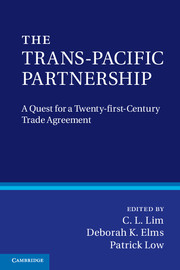Book contents
- Frontmatter
- Contents
- List of Figures and Tables
- Contributors
- Preface
- Acknowledgements
- Disclaimer
- Glossary
- Part I Introduction
- Part II The past: origins of the TPP Agreement
- 2 An overview and snapshot of the TPP negotiations
- 3 US PTAs
- 4 From the P4 to the TPP
- 5 Incorporating development among diverse members
- Part III The present: twenty-first century elements and obstacles
- Part IV The future: high-quality meets regional and global realities
- Part V The TPP negotiations: the quest for quality
- Index
- References
3 - US PTAs
what’s been done and what it means for the TPP negotiations
Published online by Cambridge University Press: 05 November 2012
- Frontmatter
- Contents
- List of Figures and Tables
- Contributors
- Preface
- Acknowledgements
- Disclaimer
- Glossary
- Part I Introduction
- Part II The past: origins of the TPP Agreement
- 2 An overview and snapshot of the TPP negotiations
- 3 US PTAs
- 4 From the P4 to the TPP
- 5 Incorporating development among diverse members
- Part III The present: twenty-first century elements and obstacles
- Part IV The future: high-quality meets regional and global realities
- Part V The TPP negotiations: the quest for quality
- Index
- References
Summary
The United States has over two decades of experience in negotiating and ratifying preferential trade agreements (PTAs). Over time, US PTAs have grown in number, sophistication and geographic scope in support of both US economic and foreign policy goals (Schott 2004). US negotiating objectives have been refined and elaborated to meet the growing challenges of international trade and investment due to globalization and to address concerns of the diverse political factions that now engage in and complicate the conduct of US trade politics. As a result, US trade negotiators expect new trade initiatives to be more comprehensive in terms of issue coverage and the depth of trade reforms.
This chapter examines the evolution of US PTA policy and how it has been reflected in the “template” for new accords that US officials present to prospective PTA partners. We summarize key components of the US PTA template and then derive lessons from the US experience that hopefully provide insights into the dynamics of the current negotiation of the Trans-Pacific Partnership (TPP) Agreement. The United States represents more than 80 percent of the combined gross domestic product (GDP) of the nine countries participating in the TPP negotiations, and undoubtedly will seek to build on the current US PTA template in crafting the new “twenty-first century” trade pact sought by the TPP countries.
- Type
- Chapter
- Information
- The Trans-Pacific PartnershipA Quest for a Twenty-first Century Trade Agreement, pp. 45 - 63Publisher: Cambridge University PressPrint publication year: 2012

